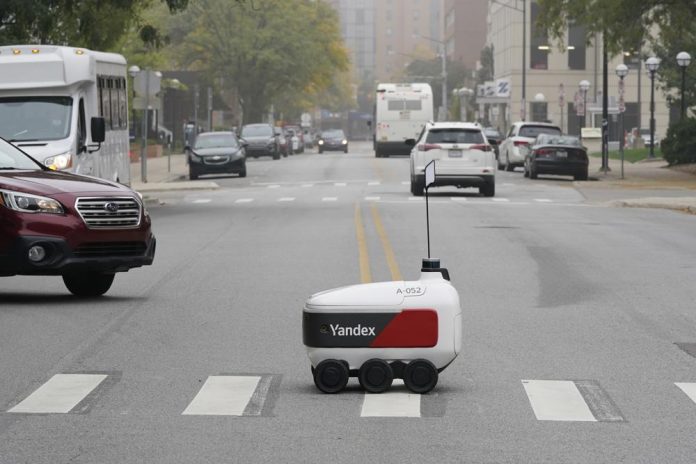Robot food delivery is no longer the stuff of science fiction. But you may not see it in your neighborhood anytime soon.
Hundreds of little robots __ knee-high and able to hold around four large pizzas __ are now navigating college campuses and even some city sidewalks in the U.S., the U.K. and elsewhere. While robots were being tested in limited numbers before the coronavirus hit, the companies building them say pandemic-related labor shortages and a growing preference for contactless delivery have accelerated their deployment.
“We saw demand for robot usage just go through the ceiling,” said Alastair Westgarth, the CEO of Starship Technologies, which recently completed its 2 millionth delivery. “I think demand was always there, but it was brought forward by the pandemic effect.”
Starship has more than 1,000 robots in its fleet, up from just 250 in 2019. Hundreds more will be deployed soon. They’re delivering food on 20 U.S. campuses; 25 more will be added soon. They’re also operating on sidewalks in Milton Keynes, England; Modesto, California; and the company’s hometown of Tallin, Estonia.
Robot designs vary; some have four wheels and some have six, for example. But generally, they use cameras, sensors, GPS and sometimes laser scanners to navigate sidewalks and even cross streets autonomously. They move around 5 mph.
Remote operators keep tabs on multiple robots at a time but they say they rarely need to hit the brakes or steer around an obstacle. When a robot arrives at its destination, customers type a code into their phones to open the lid and retrieve their food.
The robots have drawbacks that limit their usefulness for now. They’re electric, so they must recharge regularly. They’re slow, and they generally stay within a small, pre-mapped radius.
They’re also inflexible. A customer can’t tell a robot to leave the food outside the door, for example. And some big cities with crowded sidewalks, like New York, Beijing and San Francisco, aren’t welcoming them.
But Bill Ray, an analyst with the consulting firm Gartner, says the robots make a lot of sense on corporate or college campuses, or in newer communities with wide sidewalks.
“In the places where you can deploy it, robot delivery will grow very quickly,” Ray said.
Ray said there have been few reports of problems with the robots, other than an occasional gaggle of kids who surround one and try to confuse it. Starship briefly halted service at the University of Pittsburgh in 2019 after a wheelchair user said a robot blocked her access to a ramp. But the university said deliveries resumed once Starship addressed the issue.
For cheaper sidewalk robots __ which cost an estimated $5,000 or less __ it’s even easier to undercut human delivery costs. The average Grubhub driver in Ohio makes $47,650 per year, according to the job site Indeed.com.
U.S. delivery orders jumped 66% in the year ending in June, according to NPD, a data and consulting firm. And delivery demand could remain elevated even after the pandemic eases because customers have gotten used to the convenience.
